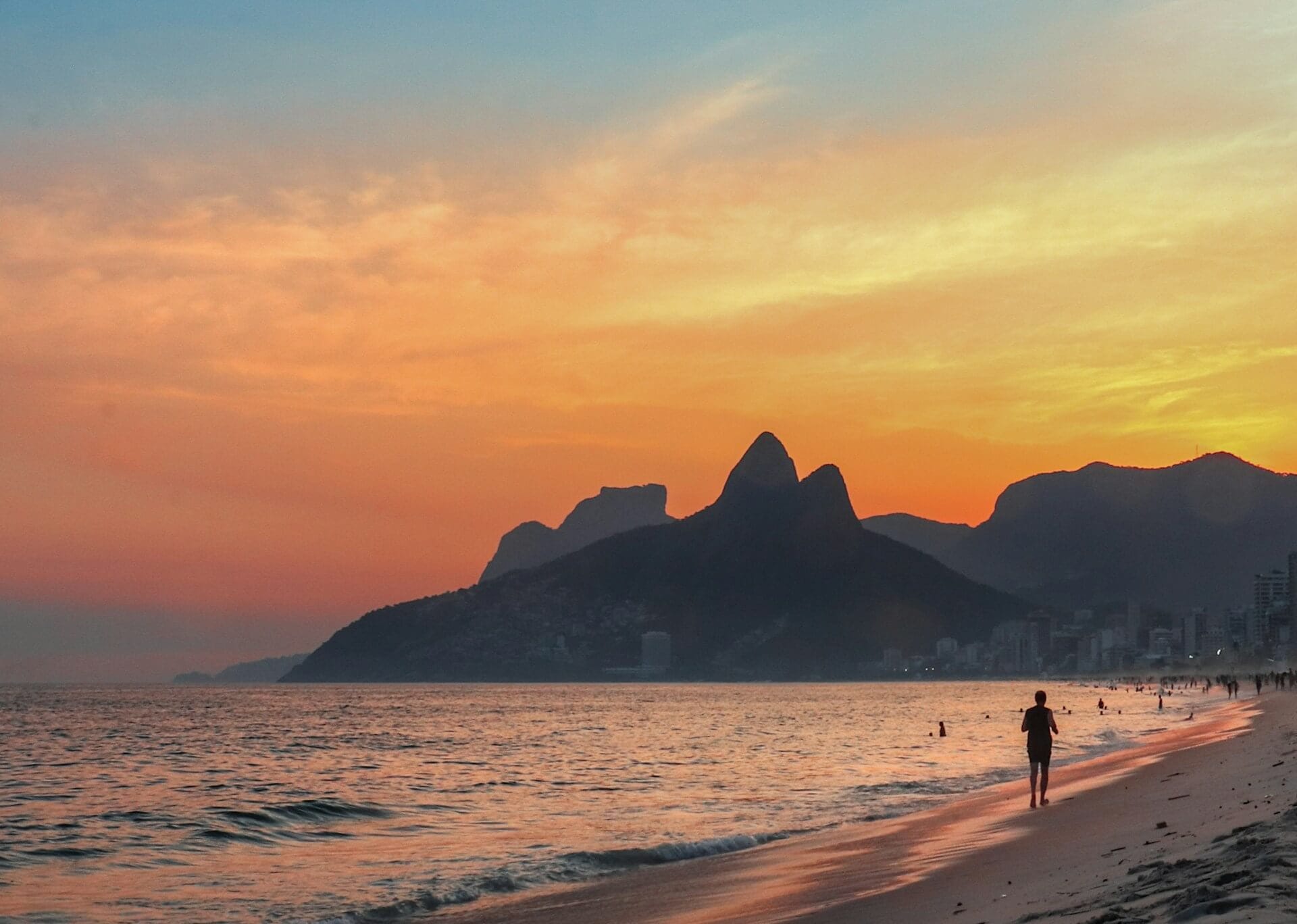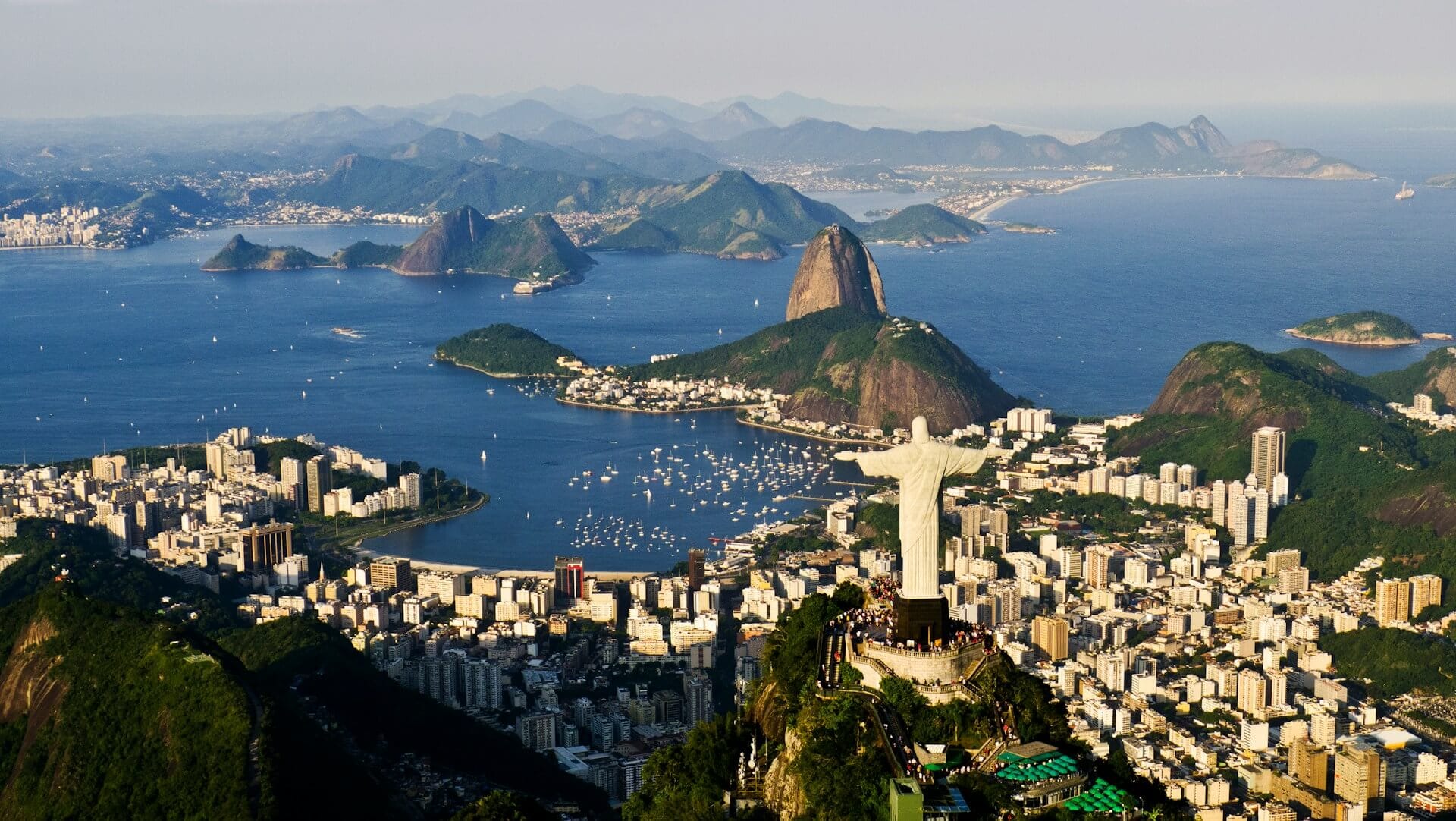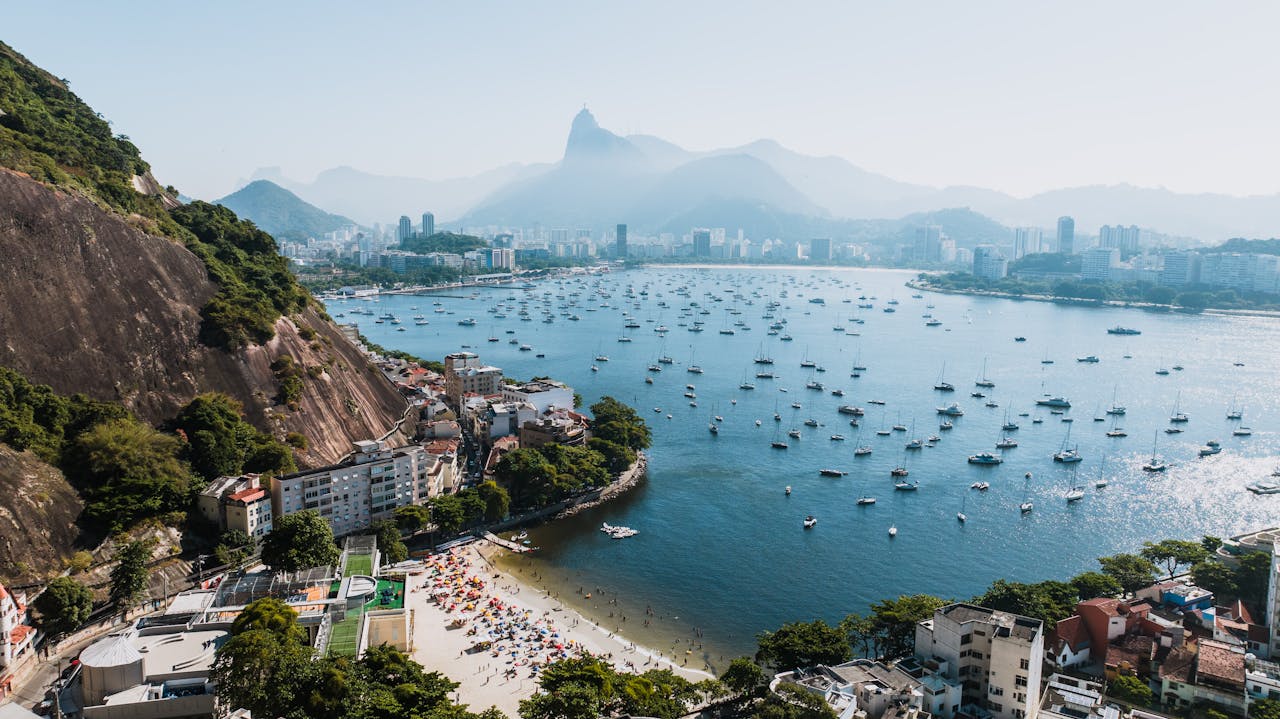
Rio de Janeiro is a unique city where urban life blends seamlessly with nature, creating an extraordinary array of experiences for visitors.
You can relax on its beautiful beaches, hike to breathtaking viewpoints, explore lush parks, admire the city from famous landmarks, visit museums, dive into its local history, try adventurous sports, and discover lagoons and other natural places that make Rio so special.
Below, discover a list of the 30 best things to do in Rio de Janeiro and make the most of the “Cidade Maravilhosa!”

Christ the Redeemer is one of the New Seven Wonders of the World and a famous symbol of Brazil. The attraction is definitely one of the best things to do in Rio de Janeiro.
Standing 38 meters tall, including its 8-meter pedestal, and weighing approximately 1,145 tons, the statue was inaugurated on October 12, 1931.
Situated at an altitude of 710 meters atop Morro do Corcovado, the monument lies in the heart of the Tijuca National Park, surrounded by lush Atlantic Forest.
Christ the Redeemer attracts around 2 million visitors annually and offers panoramic views of Rio.
The site is accessible via the Corcovado Train, official vans, or hiking trails. It provides a serene and spiritual experience, perfect for photography and contemplation.
To enhance your visit, buy tickets in advance, choose sunny days for clear views and arrive early, preferably on the first train, as I did, to avoid crowds and enjoy a more tranquil experience.
2. Ride the Sugarloaf Cable Car

A trip to Sugarloaf Mountain is one of Rio de Janeiro’s top attractions and one of its most memorable experiences. For me, it was one of the best things I did in Rio, and I simply loved it.
The mountain complex includes two peaks: the Morro da Urca and the Sugarloaf Mountain, the latter standing at 396 meters.
Visitors ascend via the famous cable car, inaugurated in 1912, which connects three stations: Praia Vermelha, Morro da Urca, and Sugarloaf Mountain. The cable car ride offers panoramic views of Rio’s landscape, blending mountains, sea, and landmarks such as Christ the Redeemer and the city’s beaches.
Around 1.5 million tourists visit annually, making it one of Rio’s most popular attractions. Beyond the cable car, visitors can explore hiking trails leading to Morro da Urca, ideal for nature enthusiasts.
The site also features relaxing spaces, cafés, and restaurants. The view from the top, especially during sunset, is simply speechless.
For the best experience, visit in the late afternoon and purchase tickets in advance to avoid lines. Opt for clear, sunny days for the most vivid views and unforgettable moments.
🌟 Don’t waste time figuring out logistics — book your Christ + Sugarloaf combo tour here and enjoy both without the stress.
Sign up Now for the Best Travel Tips exploring Brazil!
Get expert travel tips, detailed itineraries, and insider recommendations for your trip.
3. Enjoy Copacabana, Ipanema, and Leblon Beaches

The beaches of Copacabana, Ipanema, and Leblon are symbols of Rio’s lifestyle and must-visit destinations for travelers worldwide.
Located in Rio’s Zona Sul, these beaches are interconnected by boardwalks and bike paths, making it easy to explore them, whether on foot, by bike, or scooter.
Copacabana is known for its busy atmosphere and the wave-patterned stone boardwalk.
Nearby, Ipanema has clear waters and sunsets, while Leblon Beach is calmer and good for families or those looking for a quieter place.
These beaches offer a variety of activities, including swimming, surfing, and beach sports like volleyball and soccer, as well as opportunities to relax in rented chairs and umbrellas.
Seaside kiosks serve traditional Brazilian dishes, snacks, refreshing drinks, and the classic caipirinha, often accompanied by live music or performances.
At night, the atmosphere transforms, with bars and restaurants hosting shows and parties.
To make the most of your visit, arrive early, especially on sunny weekends, to secure a good spot. Walking along the boardwalk or cycling the bike paths that connect these beaches is a must-do activity.
4. Climb the Selarón Steps

The Selarón Steps, located between the neighborhoods of Lapa and Santa Teresa, is one of the most visited tourist attractions in Rio de Janeiro.
Created by Chilean artist Jorge Selarón, the steps are an open-air work of art made up of over 2,000 tiles from different countries.
With 215 steps, the staircase is much more than a pathway; it’s a cultural experience. Each tile tells a story, many of which were donated by visitors, artists, and friends of Selarón himself.
The project began in 1990, and the artist continued adding tiles until his death in 2013. Today, it is one of the most photographed spots in Rio and a must-see for tourists.
Due to its popularity, the site can get crowded, making it difficult to take photos without people in the background.
To avoid the crowds, visit as early as possible, preferably in the morning when it’s quieter. If the steps are still busy, head to the upper part of the staircase, which is generally less crowded and offers excellent photo opportunities.
5. Explore Parque Lage
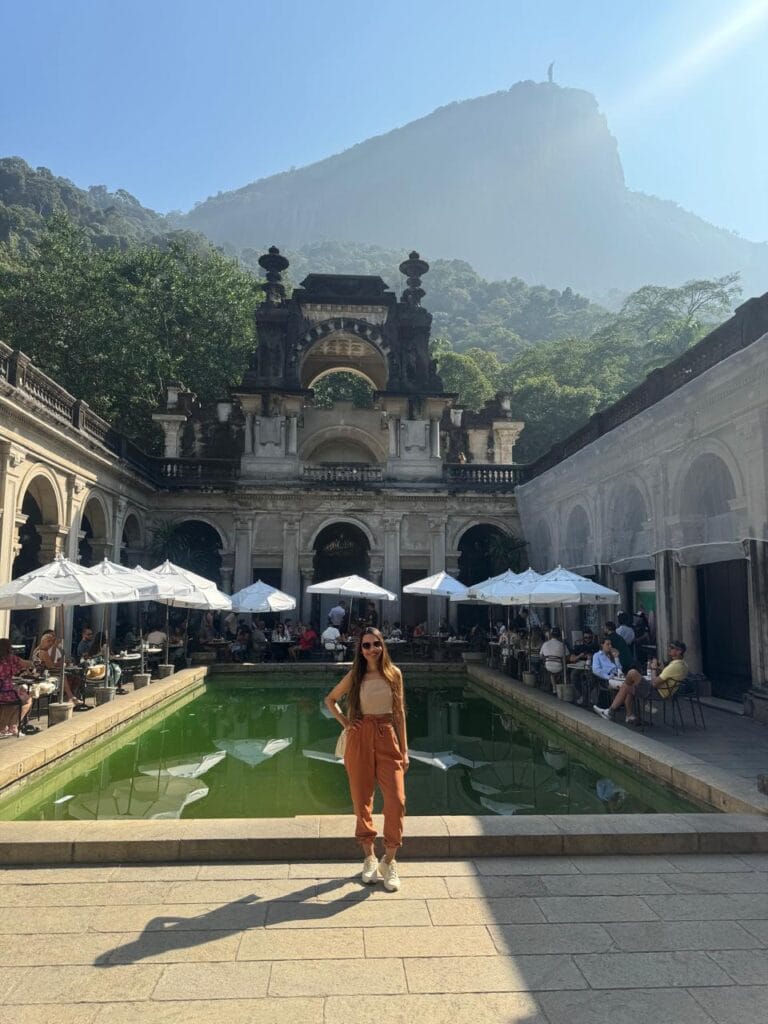
Located at the foot of Christ the Redeemer, Parque Lage is a public space that combines nature, history, and culture, and it is one of the best things to do in Rio de Janeiro.
At the heart of the park lies a historic mansion, renowned for its inner courtyard featuring a central pool and a privileged view of the Christ statue.
The park’s gardens have lawns, sculptures, and fountains that reflect its history. It also has caves and is surrounded by the Atlantic Forest, with native plants and animals like capuchin monkeys and birds, making it a good spot for those who enjoy nature.
For adventure enthusiasts, the park offers trails connecting to Tijuca National Park, leading to Christ the Redeemer. For those seeking a tranquil moment, the mansion houses a café where you can enjoy a brunch or complete breakfast, surrounded by the beauty of the park.
To make the most of your visit, it’s recommended to arrive early, especially on weekends, to avoid lines for photos or at the café.
6. Walk Through the Jardim Botânico

The Jardim Botânico of Rio de Janeiro is one of the most important botanical gardens in the world and a must-visit attraction in the city. Founded on June 13, 1808, initially to acclimate exotic species brought from other continents, such as oriental spices, it quickly became a center for research and biodiversity conservation.
Covering an area of approximately 540,000 square meters, the garden is home to over 22,000 plant species, including orchids, bromeliads, palm trees, and centuries-old trees like the famous Imperial Palm, planted in 1809.
One of the highlights is the Imperial Palm Avenue, which impresses visitors with its grandeur and beauty. The garden also features ornamental lakes, such as the one showcasing majestic victoria amazonica water lilies, and a greenhouse dedicated to orchids.
Around 700,000 people visit the Jardim Botânico annually, drawn by the environment and the opportunity to connect with nature.
We recommend arriving early, as the garden is quieter in the morning, providing a more peaceful experience. Wear sunscreen, light clothing, and comfortable shoes suitable for walking to make the most of your visit.
7. Explore the Tijuca National Park
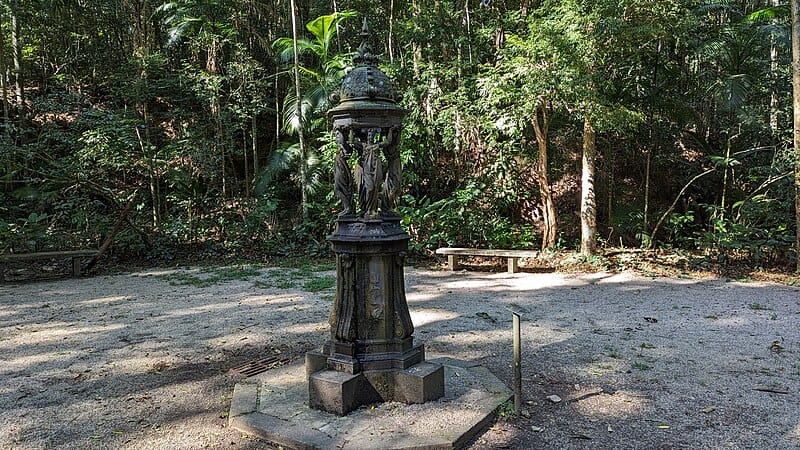
The Tijuca National Park is one of the largest urban forests in the world, covering approximately 3,953 hectares (39.53 km²) of Atlantic Forest in Rio de Janeiro.
Established in 1961, it is one of Brazil’s first national parks and plays a crucial role in preserving biodiversity and maintaining the city’s environmental balance.
The park is home to several Rio de Janeiro top attractions, including Christ the Redeemer, the Vista Chinesa, the Pedra da Gávea, and the Cachoeira do Horto. It also features over 30 trails, historic sites, and viewpoints offering views of the city.
The park is home to species like the golden lion tamarin and rare birds. Thousands of visitors come each year to enjoy the park, making it a destination for adventure enthusiasts. With trails ranging from challenging to easy, there are options for everyone.
To make the most of your visit, plan ahead by selecting the trails or attractions you want to explore and checking the weather, as rain can make some areas difficult to access.
Wear light clothing, proper hiking shoes, sunscreen, and insect repellent, and carry water and snacks to stay hydrated during your excursion. For a safer and more enriching experience, book a guided tour of Tijuca National Park here.
8. Enjoy the Sunrise or Sunset at Morro Dois Irmãos

The Morro Dois Irmãos Trail is one of the most popular hikes in Rio de Janeiro, famous for offering some of the most beautiful views of the city.
Being at the top of the hill is, for me, one of the best experiences the city offers and one of the best things to do in Rio de Janeiro.
Located in the Vidigal neighborhood, the trail leads to the peak of one of the two mountains that form Morro Dois Irmãos, at an altitude of about 533 meters.
From the top, you can enjoy a panoramic view that includes the beaches of Ipanema, Leblon, and Copacabana, Christ the Redeemer, the Rocinha Favela, and Pedra da Gávea.
The hike starts within the Vidigal community, accessible by public transportation, car, or moto-taxi.
From the starting point, the trail is about 1.5 km long, with moderate difficulty, featuring steep climbs but well-marked paths surrounded by Atlantic Forest vegetation. The hike is relatively short, taking about 40 minutes to 1 hour, depending on your pace.
The sunrise from the top is one of the most beautiful in the city, making early mornings a popular time for the hike. Sunset is also a favorite for many, as it offers equally spectacular views.
It’s recommended to do the trail with a guide, especially if you’re unfamiliar with the route, to ensure safety and make the most of the experience. Additionally, it’s recommended to check the weather forecast in advance, so you can plan hikes on sunny days.
⛰️ I strongly recommend hiking Morro Dois Irmãos with Indio, a local guide you can book here. I did this tour myself — it was safe, friendly, and truly one of the best experiences of my life.
9. Enjoy a Coffee at Confeitaria Colombo

The Confeitaria Colombo, located in Rio’s Historic Center, is considered one of the most beautiful pastry shops in the world and one of the best things to do in Rio de Janeiro.
Founded in 1894, it is known for its majestic architecture, which combines art nouveau elements, Belgian mirrors, jacaranda wood showcases, and skylights that create a sophisticated and nostalgic atmosphere.
In addition to its historical value, Colombo delights visitors with its gastronomy. The menu offers a mix of classic and contemporary dishes, featuring traditional savory and sweet treats like the famous pastéis de nata, mille-feuille, and shrimp pie.
It’s also an ideal spot for coffee or afternoon tea, providing a unique experience.
10. View the City from Mirante Dona Marta

The Mirante Dona Marta, located in Tijuca National Park, is one of the most impressive observation points in Rio de Janeiro.
At 360 meters above sea level, the viewpoint offers panoramic views, including iconic landmarks such as Christ the Redeemer, Sugarloaf Mountain, Guanabara Bay, and the beaches of Copacabana and Botafogo.
Easily accessible by car or tourist transportation and close to Christ the Redeemer, it’s an ideal spot for photography, especially at sunrise, when the view is spectacular.
The beauty of this moment attracts many photographers, guides, and tourists, making the viewpoint quite busy at this time.
11. Visit the Bars in Lapa

Lapa, located in downtown Rio de Janeiro, is renowned for its nightlife, and bohemian atmosphere. A famous landmark in the neighborhood is the Carioca Aqueduct, or Arcos da Lapa, a colonial-era structure that represents the area’s history.
At night, Lapa is one of Rio’s top entertainment hubs, with bars, restaurants, samba clubs, and nightclubs offering a variety of rhythms, including samba, forró, pagode, and electronic music. Famous samba circles and live shows attract locals and tourists alike.
The bars and restaurants cater to all tastes, offering everything from traditional snacks to elaborate dishes, alongside classic drinks like the caipirinha, all in a lively atmosphere.
Lapa gets quite crowded at night, especially on Fridays and Saturdays, so it’s best to arrive early or make reservations to secure a spot at the most popular bars and restaurants.
12. Watch the Sunset at Pedra do Arpoador

The Pedra do Arpoador, located between Copacabana and Ipanema beaches, is one of Rio de Janeiro’s most well-known spots.
Famous for being the place where the sun “sets into the sea” during summer, it is one of the best locations in the city to watch the sunset, attracting both locals and tourists who applaud the sunset every day.
Easily accessible, the rock is an extension of Arpoador Beach and offers views of Ipanema and Leblon beaches, with the Morro Dois Irmãos mountain as a backdrop.
Besides being a spot for contemplation, Arpoador is also popular among surfers due to the waves in the area. The surrounding boardwalk features kiosks and walking paths, making it a meeting point.
I recommend arriving early to secure a good spot and enjoy the peaceful atmosphere before the sunset.
13. Visit the Maracanã Stadium

The Maracanã Stadium, inaugurated in 1950, is a must-see for sports fans and those interested in Rio’s history. Located in the city’s Zona Norte, the stadium has hosted historic moments, such as the 1950 World Cup Final, and the opening and closing ceremonies of the 2016 Olympic Games.
A guided tour of the stadium allows visitors to explore its behind-the-scenes areas, including the pitch, locker rooms, press tribune, and the Maracanã Museum, which showcases trophies, uniforms, and photos of legendary players.
If possible, attend a football match at the stadium to experience the excitement of this historic place.
14. Hike the Pedra da Gávea Trail
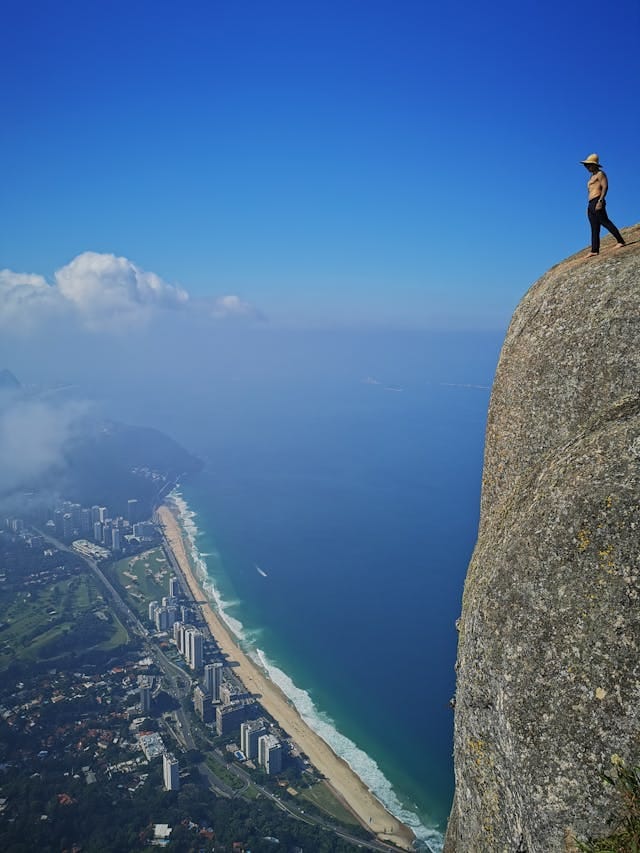
The Pedra da Gávea Trail, located in Tijuca National Park, is one of the most challenging yet rewarding hikes in Rio de Janeiro.
Standing at an altitude of 844 meters, Pedra da Gávea is considered the largest monolith by the sea in the world, offering spectacular panoramic views of the city.
The trail spans approximately 3 km and demands good physical preparation due to its steep terrain and technical sections, such as the Carrasqueira, a rock wall requiring basic climbing skills.
To undertake this hike, you must be physically prepared and accustomed to trekking, as it is rated difficult.
Wear proper gear, including light clothing, sturdy hiking boots or shoes with good grip, sunscreen, insect repellent, and carry a backpack with water and energy snacks.
Hiring a specialized guide is strongly recommended, especially for navigating the Carrasqueira section safely. You can book a trusted Pedra da Gávea hike here and enjoy the climb with expert support and safety.
Avoid rainy days, as the trail can become slippery and more dangerous. Finally, start early, as the hike can take 4 to 6 hours round trip, making the morning the best time to enjoy the view with natural light.
15. Enjoy Coffee at Forte de Copacabana

The Forte de Copacabana, located at the end of Copacabana Beach, is one of the most charming attractions in Rio de Janeiro, combining history, culture, and gastronomy.
Built in 1914, the fort played a strategic role in defending the city and now houses the Museum of the Army’s History, featuring exhibits on Brazilian military history and the evolution of the fortification.
Beyond its historical importance, the fort offers panoramic views of the beach and Sugarloaf Mountain, making it a good place to relax and admire the scenery.
One of its main highlights is the cafés and bistros, such as Café 18 do Forte and a branch of the famous Confeitaria Colombo, which offer a unique experience. With outdoor seating and a sensational view, these spots serve cakes, pastries, and brunch options.
16. Take a Photo at Pedra do Telégrafo

Pedra do Telégrafo is famous for its “daring” photos that create the illusion of being on the edge of a cliff. The trail to the site is one of the most popular hikes in Rio de Janeiro.
The trail is about 1.5 km long, with moderate difficulty, and takes 40 minutes to 1 hour to complete. It winds through the Atlantic Forest, offering contact with nature and views of the region’s wild beaches and surrounding mountains.
The rock gained fame on social media for creative photos simulating risky poses, but the base is safe.
It’s best to visit in the morning or at sunset to avoid the intense heat and enjoy the best lighting conditions for photos. Keep in mind that the trail is very popular and may have lines for photos during peak times.
17. Hang Glide at Pedra Bonita
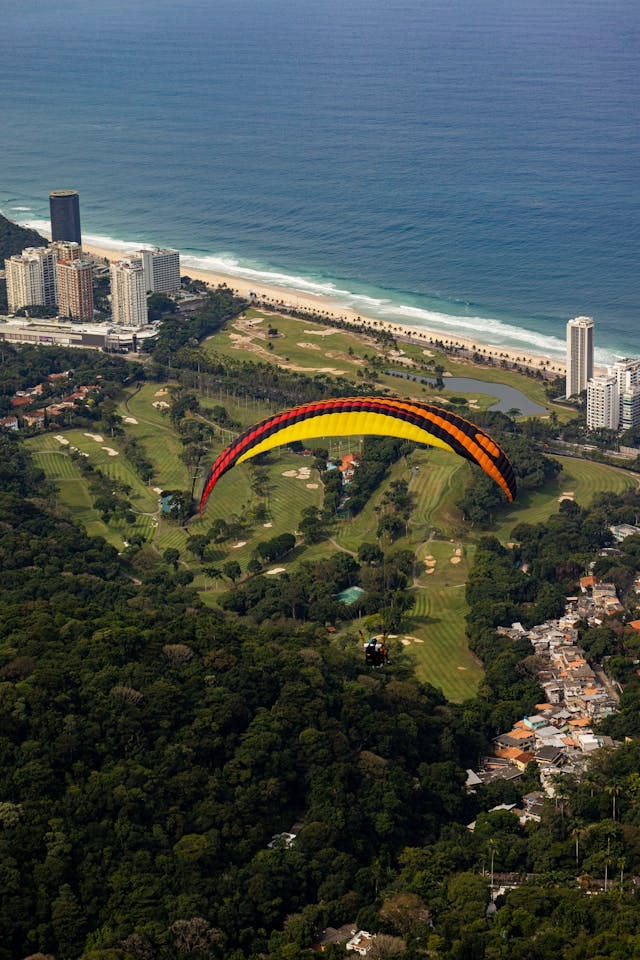
Hang gliding from Pedra Bonita is one of the most thrilling experiences in Rio de Janeiro.
Located in the Tijuca National Park, Pedra Bonita, at an altitude of about 520 meters, serves as the takeoff point for hang gliding and paragliding, offering the chance to soar over the city’s beaches, mountains, and forests.
The flight ends with a landing at São Conrado Beach, after 10-minute journey through the air.
The flight offers panoramic views and the activity is conducted with experienced instructors and certified equipment, making it safe and accessible even for beginners.
The takeoff point itself is a natural viewpoint, worth a visit even if you don’t plan to fly. It is recommended to book the activity in advance, as weather conditions can affect flight schedules.
👉 Book your hang gliding flight here for a safe and unforgettable experience — fly with certified instructors over some of the most scenic spots in Rio.
18. Be Amazed by the Royal Portuguese Reading Room

The Royal Portuguese Reading Room, located in Rio de Janeiro’s Historic Center, is one of the most beautiful and impressive libraries in the world. It’s impossible not to marvel at this breathtaking site.
Founded in 1837 by Portuguese immigrants, the library aims to preserve and promote Portuguese culture and literature. The current building, inaugurated in 1887, is a masterpiece of neo-Manueline architecture, with a detailed façade and a majestic interior that enchants visitors.
Its collection includes over 350,000 volumes, featuring rare editions of classic Portuguese authors, historical documents, and unique manuscripts.
The main hall, with bookshelves that stretch to the ceiling, is a visual spectacle, illuminated by a central skylight that enhances its grandeur.
19. Explore the Santa Teresa Neighborhood

The Santa Teresa neighborhood is one of the most cultural areas of Rio de Janeiro, known for its cobblestone streets, historic mansions, and bohemian atmosphere.
Situated on a hill in the city center, Santa Teresa offers beautiful views of Rio and a blend of art, gastronomy, and history.
Among its main attractions are the famous Santa Teresa Tram, which connects the neighborhood to downtown, and the Selarón Steps, one of Rio’s most famous landmarks.
Santa Teresa is also home to numerous art studios, galleries, and the Parque das Ruínas, a cultural center that combines historic ruins with event spaces and views of the city.
I recommend taking the tram to the neighborhood. Once there, explore the streets on foot to admire the historic architecture, urban, and art murals.
To wrap up your visit, stop by one of the area’s famous bars or restaurants, where you can enjoy anything from traditional Brazilian dishes to international cuisine, all in a welcome atmosphere.
20. Watch a Samba Show
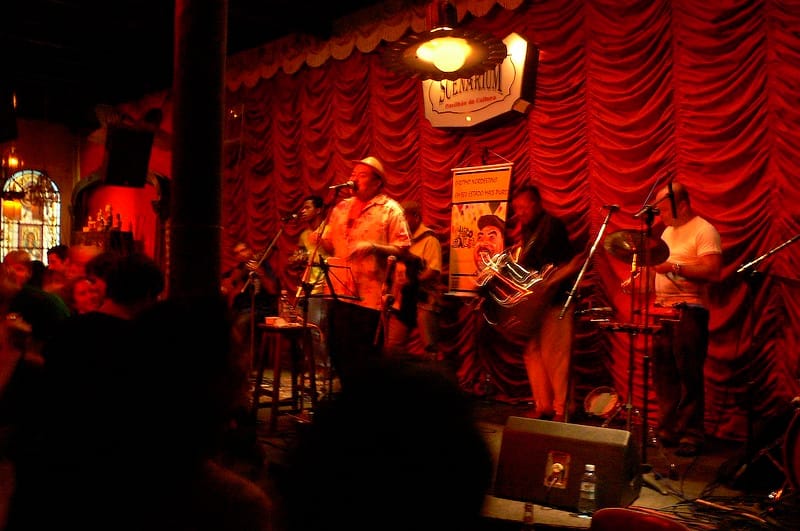
Watching a samba show is one of the most authentic and exciting experiences Rio de Janeiro has to offer. As a symbol of Brazilian culture, samba combines music, dance, and energy, celebrating the joy and soul of the Brazilian people.
Traditional samba houses like Carioca da Gema and Rio Scenarium, both located in Lapa, host live shows featuring classic samba, pagode, and other Brazilian rhythms.
For a more open-air experience, visit Pedra do Sal, a historic spot where locals and visitors gather to enjoy samba sessions in a lively and informal setting.
For an even more immersive experience, visit the rehearsal spaces of samba schools like Mangueira or Salgueiro, which hold open practices for the public, especially in the months leading up to Carnival.
21. Explore the Historic Center

The Historic Center of Rio de Janeiro is a journey back in time, with streets, squares, and buildings that preserve centuries of history and culture.
Walking through the area is an opportunity to visit landmarks like the Paço Imperial, once the residence of the Portuguese royal family, and the Candelária Church, renowned for its grandeur and architectural beauty.
Other highlights include the Royal Portuguese Reading Room, with its stunning neo-Gothic architecture and vast collection of books, and the Monastery of São Bento, a Baroque masterpiece adorned with golden details.
The area is also home to museums such as the National Museum of Fine Arts and the Historical National Museum, which provide a deep dive into Brazil’s art and history.
Additionally, don’t miss the impressive Metropolitan Cathedral, known for its cone-shaped design and stained-glass windows that stretch from floor to ceiling, creating a unique interplay of light.
Another highlight is the Municipal Theater, one of the most beautiful buildings in the country, inspired by the Paris Opera House, offering guided tours and a cultural program featuring classical music, ballet, and theater performances.
Since many attractions are close to each other, exploring the Historic Center on foot allows you to appreciate the rich architectural and historical details.
Make sure to try traditional dishes at the area’s cafés, bars, and restaurants, such as the iconic Confeitaria Colombo or the bars on Rua do Ouvidor, one of the main bohemian hubs in the area.
22. Visit the Museum of Tomorrow

The Museum of Tomorrow, located in the Olympic Boulevard, is one of the most visited museums in Brazil.
Inaugurated in 2015, the museum draws attention with its futuristic architecture, inspired by the shapes of nature, and its privileged location overlooking the Guanabara Bay.
Dedicated to science, sustainability, and the future of humanity, the museum features interactive exhibitions that invite visitors to reflect on global issues such as climate change, biodiversity, technological advances, and the challenges of building a sustainable planet.
We recommend purchasing tickets in advance here to avoid lines, especially on weekends and holidays. Don’t miss the chance to explore the surrounding area of the Olympic Boulevard and visit the nearby Museum of Art of Rio (MAR).
23. Explore the Olympic Boulevard

The Olympic Boulevard, located in Rio de Janeiro’s port zone near the Historic Center, is a revitalized area that has become one of the city’s top tourist and cultural attractions.
Created for the 2016 Olympic Games, the space combines art, leisure, and entertainment, making it great for walks, scooter rides, or bike rides along its 3.5 km stretch.
Its main highlights include the famous “Ethnicities” mural by artist Eduardo Kobra, one of the largest graffiti murals in the world, and the futuristic Museum of Tomorrow, with interactive exhibitions on science and sustainability.
The AquaRio, the largest aquarium in South America, is another must-visit, especially for families, offering an interactive experience that delights visitors of all ages.
Additionally, the Rio Star Ferris Wheel, the tallest in Latin America at 88 meters, provides spectacular panoramic views of the city.
24. Visit AquaRio

The AquaRio, located in the Olympic Boulevard, is the largest marine aquarium in South America and one of the city’s most popular attractions.
Inaugurated in 2016, the facility spans over 26,000 square meters and is home to approximately 8,000 animals from 350 different species, providing an educational and fascinating experience for visitors of all ages.
The highlight of AquaRio is the ocean tank, the largest in the complex, measuring 7 meters deep and featuring an underwater tunnel that allows visitors to walk beneath sharks, rays, and other marine species.
The aquarium also offers interactive experiences, such as the touch tank, where visitors can feel the textures of starfish and sea urchins.
25. Enjoy Barra da Tijuca Beach
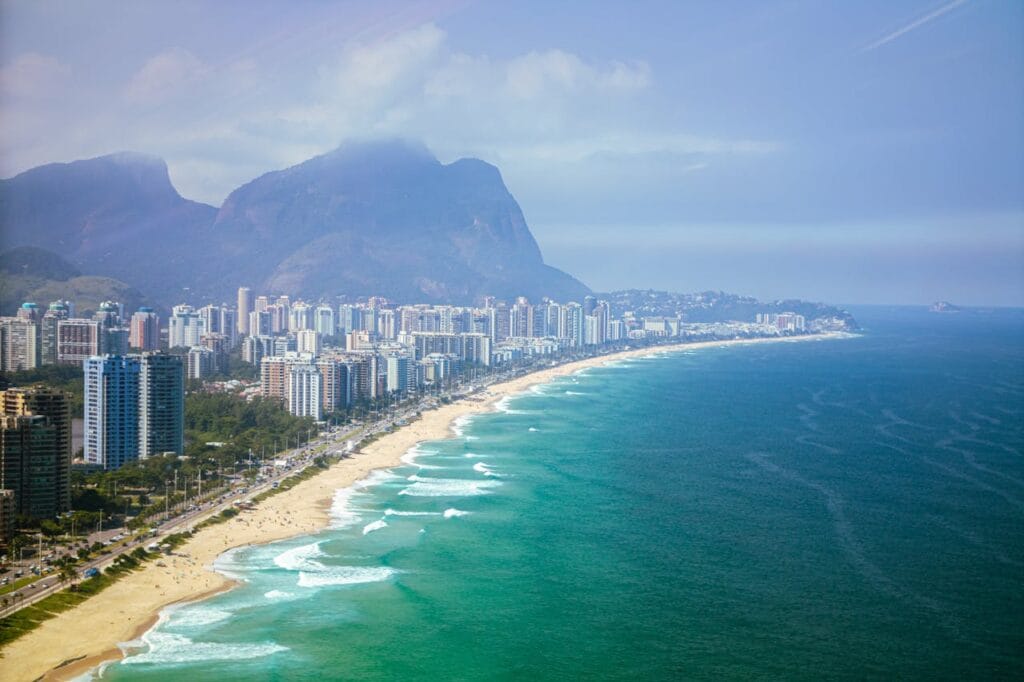
With its 18 km of shoreline, Barra da Tijuca Beach is the largest beach in Rio de Janeiro and one of the most versatile, ideal for those seeking a more tranquil, spacious location.
Located in the city’s West Zone, it attracts both locals and tourists who come to relax, enjoy water sports, or simply take in the natural beauty of the area.
The beach is famous for its excellent conditions for surfing, kite surfing, and stand-up paddleboarding, particularly in the area known as Pepê, named after the legendary surfer Pepê Lopes.
Additionally, the beachfront is well-equipped, with kiosks offering drinks, snacks, and traditional dishes, as well as a bike path perfect for walking or cycling.
26. Take a Boat Tour on Guanabara Bay
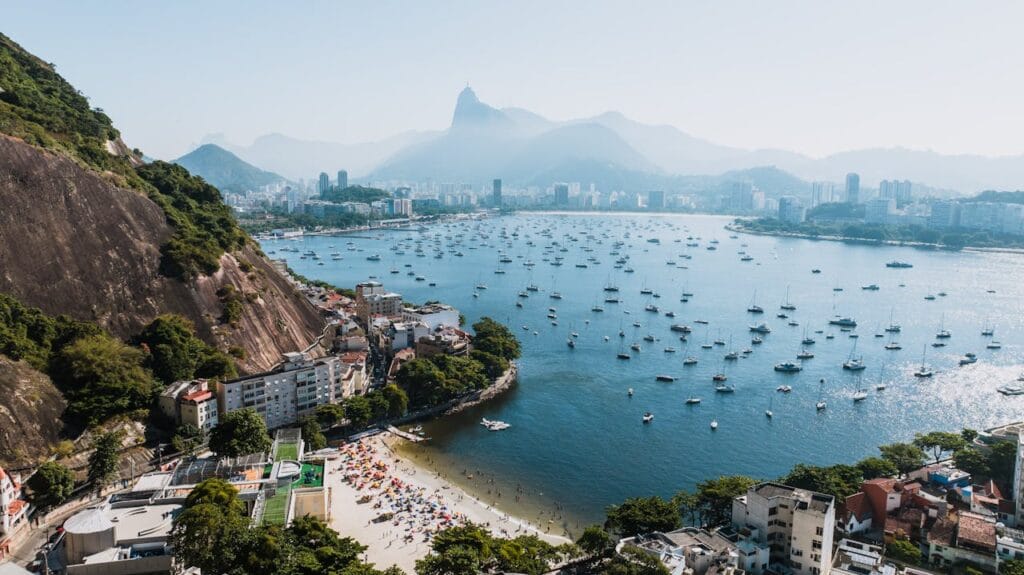
A boat tour on Guanabara Bay is an amazing way to explore Rio de Janeiro from a different perspective.
During the trip, you can admire some of the city’s most famous landmarks, such as Sugarloaf Mountain and Christ the Redeemer. The tour also offers exclusive views of the mountains, beaches, and Rio’s skyline, providing a unique experience.
The experience varies depending on the type of vessel chosen, ranging from traditional boats and speedboats to luxurious sailboats. Some tours even include stops for swimming at nearby beaches or onboard drinks and meals, making the outing even more special.
👉 Book your boat tour here and enjoy Rio from the water with unforgettable views and optional extras.
27. Stroll Around Lagoa Rodrigo de Freitas

The Lagoa Rodrigo de Freitas, located in Rio’s Zona Sul, is one of the city’s most beautiful and serene spots, perfect for outdoor activities and relaxation.
Surrounded by neighborhoods like Ipanema, Leblon, and Jardim Botânico, the lagoon offers views of Christ the Redeemer and the surrounding mountains.
With a 7.5 km bike path, it’s ideal for walking, jogging, biking, and rollerblading. Visitors can also rent bicycles, swan-shaped pedal boats, and kayaks to explore the lagoon in a unique way.
The area features kiosks serving light meals, drinks, and traditional dishes, as well as playgrounds and green spaces for family picnics. The sunset at the lagoon is simply stunning.
28. Discover Other Beaches in Rio de Janeiro

For those looking to escape the hustle and bustle of Rio’s famous beaches, the city offers peaceful and idyllic alternatives such as Prainha and Grumari, located in the Zona Oeste.
Surrounded by Atlantic Forest vegetation and with more restricted access, these beaches are perfect for relaxing in nature.
Prainha, with its crystal-clear waters and strong waves, is a favorite among surfers and is a protected environmental area. Grumari, larger and equally preserved, offers a more family-friendly environment, with a sense of exclusivity.
Other options include Praia do Secreto, a small natural pool hidden among the rocks, and Praia da Reserva, known for its pristine landscape and tranquil atmosphere.
29. Explore the Favelas Rocinha, Vidigal, or Santa Marta

Exploring the Rocinha, Vidigal, and Santa Marta favelas is an authentic and culturally experience in Rio de Janeiro. Each of these communities offers a unique glimpse into carioca life, combining views of the city, local hospitality, and cultural diversity.
Rocinha, the largest favela in Brazil, is known for its lively atmosphere, narrow streets filled with shops, and tours showcasing social and cultural projects like art and music workshops.
Vidigal, located next to Morro Dois Irmãos, attracts visitors with its spectacular views and growing nightlife, featuring bars and parties popular with both locals and tourists.
Santa Marta, internationally famous, is a symbol of resilience and art, standing out with its colorful murals and the Michael Jackson statue, commemorating the filming of the “They Don’t Care About Us” music video in the community.
We recommend visiting with guides, as many residents offer guided tours, providing a safe and immersive experience.
👉 Tip: This favela tour is led by locals and offers respectful, eye-opening insight into life in the community.
30. Helicopter Tour Over Rio de Janeiro
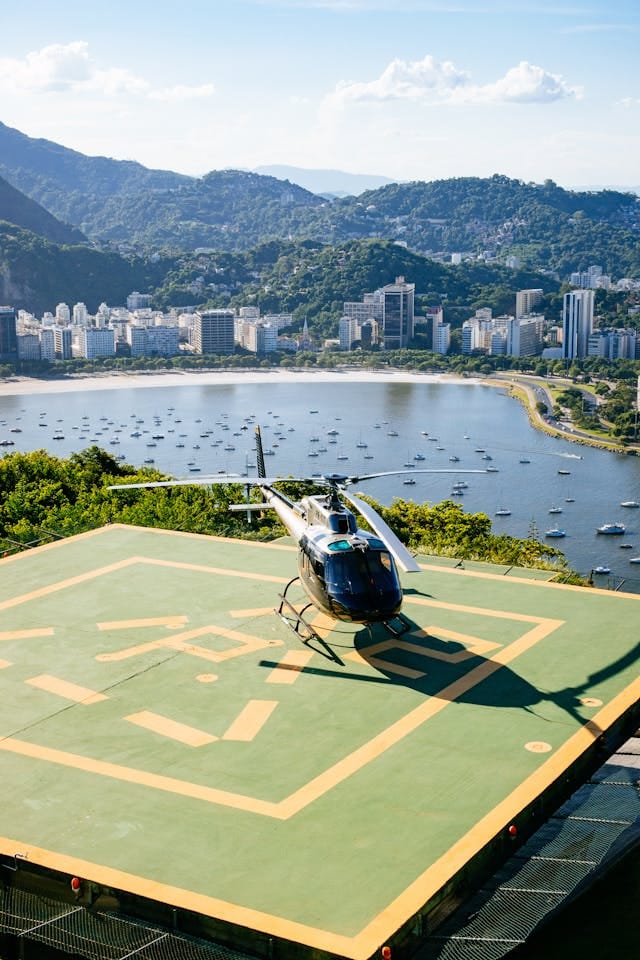
A helicopter tour is one of the most exciting ways to see Rio de Janeiro. From above, you can get an amazing view of famous places like the Christ the Redeemer statue on Corcovado Mountain and Sugarloaf Mountain near Guanabara Bay.
You will also see the long stretches of Copacabana and Ipanema beaches, as well as the city’s neighborhoods.
There are different options for tours, with flights lasting from 10 to 30 minutes, like this one that’s highly recommended. It’s a great way to see the city from a new perspective and take memorable photos. If you want to experience Rio from the sky, this is a great choice.
Conclusion: Best things to do in Rio de Janeiro
From peaceful spots to exciting activities, Rio de Janeiro has something for all types of travelers. Use this guide to discover the places and experiences that best match your interests and enjoy every moment in the “Cidade Maravilhosa.”

